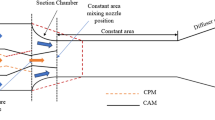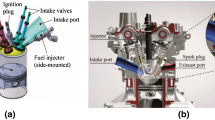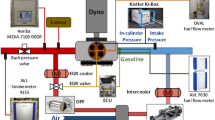Abstract
One important parameter influencing mixture formation and spray/wall interaction within engines is the geometry of the nozzle. In contrast to Diesel nozzles, the influence of the orifice geometry on spray formation has hardly be investigated for gasoline nozzles. In order to demonstrate the potential of adjusting the nozzle geometry of a modern GDI nozzle, we compare two six-hole, high-pressure nozzles with an identical structure, but different rounding radius of the orifice hole-inlet and different orifice hole-geometries: nozzle A with a rounded inlet and an orifice length to diameter ratio of 3/2 and nozzle B with a sharp inlet and an orifice length to diameter ratio of 1. In a first measurement campaign the spray formation is visualized using high-speed shadowgraphy imaging. The results show differences in spray angle and penetration depth. In a second measurement campaign we examine the spray/wall interaction and wall film formation by means of infrared thermography. The thermography measurements indicate that the geometry of nozzle B produces sprays with beneficial characteristics. This is very important for a clean combustion process and a decrease of soot emissions.
Similar content being viewed by others
Abbreviations
- A:
-
area, m2
- p:
-
pressure, Pa
- Q:
-
heat, J
- q:
-
heat flux, W/m2
- t:
-
time, s
- a:
-
ambient
- asoi:
-
after start of injection
- swi:
-
spray/wall interaction
References
Bai, Y., Fan, L. Y., Ma, X. Z., Peng, H. L. and Song, E. Z. (2016). Effect of injector parameters on the injection quantity of common rail injection system for diesel engines. Int. J. Automotive Technology 17, 4, 567–579
Breuninger, T., Schmidt, J., Tschöke, H. and Hese, M. (2015). Optical investigations of the ignition-relevant spray characteristics from a piezo-injector for sprayguided spark-ignited engines. SAE Int. J. Engines 8, 1, 89–100
Butcher, A. J., Aleiferis, P. G. and Richardson, D. (2013). Development of a real-size optical injector nozzle for studies of cavitation, spray formation and flash-boiling at conditions relevant to direct-injection spark-ignition engines. Int. J. Engine Research 14, 6, 557–577
Choi, S., Myung, C. L. and Park, S. (2014). Review on characterization of nano-particle emissions and PM morphology from internal combustion engines: Part 2 Int. J. Automotive Technology 15, 2, 219–227
Heldmann, M., Bornschlegel, S. and Wensing, M. (2015). Investigation of jet-to-jet interaction in sprays for DISI engines. SAE Paper No. 2015–01-1899
Jiao, Q. and Reitz, R. (2015). The effect of operating parameters on soot emissions in GDI engines. SAE Int. J. Engines 8, 3,1322–1333
Kalantari, D. and Tropea, C. (2014). Liquid spray impact onto flat and rigid walls: Formation and spreading of accumulated wall film. FDMP 10, 1, 37–61
Khan, M., Hélie, J., Gorokhovski, M. and Sheikh, N. A. (2017). Air entrainment in high pressure multihole gasoline direct injection sprays. J. Applied Fluid Mechanics 10, 4, 1223–1234
Köpple, F., Jochmann, P., Kufferath, A. and Bargende, M. (2013). Investigation of the parameters influencing the spray-wall interaction in a GDI engine-Prerequisite for the prediction of particulate emissions by numerical simulation. SAE Int. J. Engines 6, 2, 911–925
Lee, C. H. (2017). Effect of nozzle orifice diameter on diesel spray tip penetration according to various spray models for CFD simulation with widely varying back pressure. Int. J. Automotive Technology 18, 2, 317–325
Lee, C. H., Lee, K. H. and Lim, K. B. (2010). Effects of injection parameters on the spray characteristics of swirl and slit injectors using the Mie-scattering method. Int. J. Automotive Technology 11, 3, 435–440
Lim, O. T. and Lee, S. J. (2016). Influence of nozzle hole diameter and orifice diameter on dme spray to get the similar heat value with diesel spray using the constant volume chamber. Int. J. Automotive Technology 17, 6, 1023–1031
Merker, G. P., Schwarz, C. and Teichmann, R. (2012). Grundlagen Verbrennungsmotoren: Funktionsweise, Simulation, Messtechnik: PRAXIS. — ATZ/MTZFachbuch. Vieweg+Teubner. Verlag. Wiesbaden, Germany.
Moreira, A., Moita, A. S. and Panaõ, M. R. (2010). Advances and challenges in explaining fuel spray impingement: How much of single droplet impact research is useful?. Progress in Energy and Combustion Science 36, 5, 554–580
Payri, R., Salvador, F. J., Gimeno, J. and De la Morena, J. (2009). Study of cavitation phenomena based on a technique for visualizing bubbles in a liquid pressurized chamber. Int. J. Heat and Fluid Flow 30, 4, 768–777
Schulz, F. and Schmidt, J. (2012). Infrared thermography based fuel film investigations. 12th Trinnial Int. Conf. Liquid Atomization and Spray Systems, Heidelberg, Germany.
Schulz, F., Schmidt, J., Kufferath, A. and Samenfink, W. (2014). Gasoline wall films and spray/wall interaction analyzed by infrared thermography. SAE Int. J. Engines 7, 3, 1165–1177
Schulz, F., Samenfink, W., Schmidt, J. and Beyrau, F. (2016). Systematic LIF fuel wall film investigation. Fuel, 172, 284–292
Schulz, F. and Beyrau, F. (2017). The influence of flashboiling on spray-targeting and fuel film formation. Fuel, 208, 587–594
Shost, M., Lai, M., Befrui, B. and Spiekermann, P. (2014). GDi nozzle parameter studies using LES and spray imaging methods. SAE Paper No. 2014–01-1434
Wetzel, J., Henn, M., Gotthardt, M. and Rottengruber, H. (2015). Experimental investigation of the primary spray development of gdi injectors for different nozzle geometries. SAE Paper No. 2015–01-0911
Author information
Authors and Affiliations
Corresponding author
Rights and permissions
About this article
Cite this article
Schulz, F., Beyrau, F. Comparison of the Spray and the Spray/Wall Interaction of Two Gasoline Injectors. Int.J Automot. Technol. 19, 615–622 (2018). https://doi.org/10.1007/s12239-018-0058-4
Received:
Revised:
Accepted:
Published:
Issue Date:
DOI: https://doi.org/10.1007/s12239-018-0058-4




